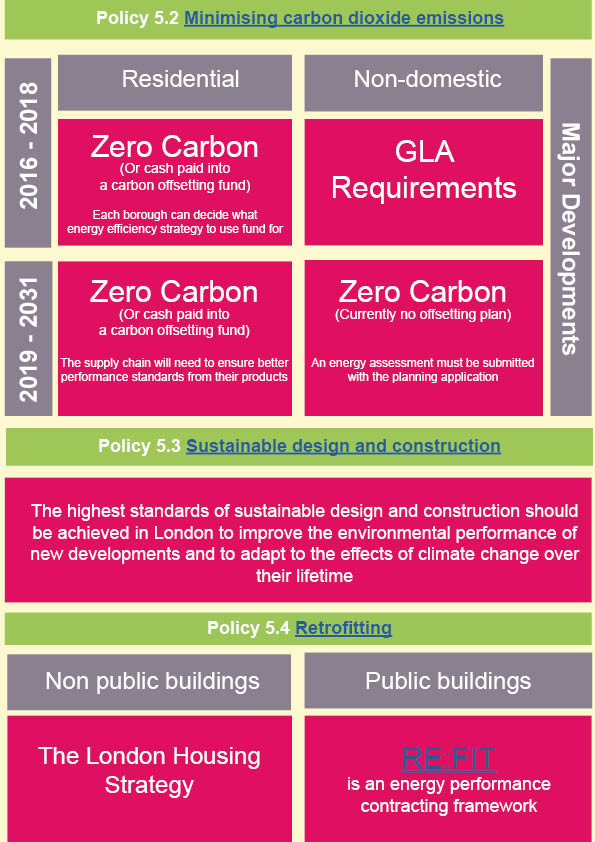The London Plan states that from October 1st 2016, major developments of both domestic and commercial buildings within London will need to be zero carbon. This requirement is 35% higher than that stipulated in Part L of current national building regulations. Developers who fall foul of these more stringent regulations will be required to pay penalties. These payments will be used by the GLA (Greater London Authority) to support current carbon offsetting projects.
 Chapter five of the London Plan outlines policies which underpin the ‘London’s Response To Climate Change Strategy’. This strategy has been created around the original commitment to the Kyoto agreement by the government to reduce carbon emissions to 80% lower than 1990 levels by 2050. This figure was in turn derived from experts that form, ‘The Committee for Climate Change’, which was setup to advise the government on how to meet the requirements of the Kyoto agreement.
In the original London Plan published in 2011 by the then Lord Major of London, Boris Johnson, climate change and its amelioration formed a central plank to its strategy, London should: ‘excel among global cities – expanding opportunities for all its people and enterprises, achieving the highest environmental standards and quality of life and leading the world in its approach to tackling the urban challenges of the 21st century, particularly that of climate change’.
To achieve this urban utopia, The London Plan is divided up into six key, measurable objectives:
Chapter five of the London Plan outlines policies which underpin the ‘London’s Response To Climate Change Strategy’. This strategy has been created around the original commitment to the Kyoto agreement by the government to reduce carbon emissions to 80% lower than 1990 levels by 2050. This figure was in turn derived from experts that form, ‘The Committee for Climate Change’, which was setup to advise the government on how to meet the requirements of the Kyoto agreement.
In the original London Plan published in 2011 by the then Lord Major of London, Boris Johnson, climate change and its amelioration formed a central plank to its strategy, London should: ‘excel among global cities – expanding opportunities for all its people and enterprises, achieving the highest environmental standards and quality of life and leading the world in its approach to tackling the urban challenges of the 21st century, particularly that of climate change’.
To achieve this urban utopia, The London Plan is divided up into six key, measurable objectives:
 Chapter five of the London Plan outlines policies which underpin the ‘London’s Response To Climate Change Strategy’. This strategy has been created around the original commitment to the Kyoto agreement by the government to reduce carbon emissions to 80% lower than 1990 levels by 2050. This figure was in turn derived from experts that form, ‘The Committee for Climate Change’, which was setup to advise the government on how to meet the requirements of the Kyoto agreement.
In the original London Plan published in 2011 by the then Lord Major of London, Boris Johnson, climate change and its amelioration formed a central plank to its strategy, London should: ‘excel among global cities – expanding opportunities for all its people and enterprises, achieving the highest environmental standards and quality of life and leading the world in its approach to tackling the urban challenges of the 21st century, particularly that of climate change’.
To achieve this urban utopia, The London Plan is divided up into six key, measurable objectives:
Chapter five of the London Plan outlines policies which underpin the ‘London’s Response To Climate Change Strategy’. This strategy has been created around the original commitment to the Kyoto agreement by the government to reduce carbon emissions to 80% lower than 1990 levels by 2050. This figure was in turn derived from experts that form, ‘The Committee for Climate Change’, which was setup to advise the government on how to meet the requirements of the Kyoto agreement.
In the original London Plan published in 2011 by the then Lord Major of London, Boris Johnson, climate change and its amelioration formed a central plank to its strategy, London should: ‘excel among global cities – expanding opportunities for all its people and enterprises, achieving the highest environmental standards and quality of life and leading the world in its approach to tackling the urban challenges of the 21st century, particularly that of climate change’.
To achieve this urban utopia, The London Plan is divided up into six key, measurable objectives:
- A city that meets the challenges of economic and population growth
- An internationally competitive and successful city
- A city of diverse, strong, secure and accessible neighbourhoods
- A city that delights the senses
- A city that becomes a world leader in improving the environment
- A city where it is easy, safe and convenient for everyone to access jobs, opportunities and facilities.
- Date
- Category
- The Built Environment